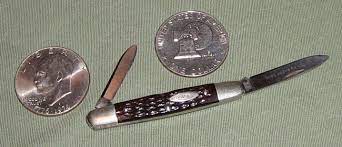![]()
Return to Index/Main Page
| A lexicon of knife terminology: Section E | ||||||||||||||||||||||||||
| Numbers | A | B | C | D | E | F | G | H | I | J | K | L | M | N | O | P | Q | R | S | T | U | V | W | X | Y | Z |
Easy Open (EZ open): A knife with a U-shaped notch cut out along the handle making it easier for the closed blades to be grabbed and opened. The U shaped notch allows the knife blade to be pinched which means that no nail nick is required in the blade. However, many easy open knives still have the nail nick.

Ebony: A dense black wood yielded by several species of plants in the genus Diospyros, sometimes used in knife handles. Other types of woods may be passed off as ebony and some wood will be dyed to look like ebony. A Reputable dealer or manufacturer will use the term black wood for woods not from genus Diospyros, genuine Ebony is so dense that it will not float in water. This makes it impervious to sweat and most liquids making it ideal for knife handles.
EDC: See every day carry
Edge: The cutting portion of a blade.
Eisenhower: Originally a Case Pattern 63 penknife which was favored by President Eisenhower and given out as gifts while he was President. Case later changed the pattern name to Eisenhower. It is an equal end pen knife with a spear and pen blade on opposite ends similar to a Senator knife. In some instances, a Case Eisenhower knife will have President Eisenhower’s signature etched in the main blade. See Senator Knife for comparison.

Case 4 dot (1976) Eisenhower Knife
Electrician's knife: A knife used by electricians which will have a main blade either (normally a spear master) and secondary blade that acts a screwdriver, wire stripper/bender. The military version is often called a linesman knife or a TL-29. The screwdriver normally locks in place with the aid of a liner lock.
Elephant Toenail: A traditional pattern folding knife; The elephant toenail dates from the late 19th/early 20th Century. The pattern features a very wide handle allowing for wide blades. The name refers to the shape of the knife resembling an elephant’s toenail. The Elephant’ toenail features sleeve board or teardrop shape handle. The knife normally has two blades, one on each end. These are normally a wide spear blade with a secondary pen blade. As the pattern became popular it picked up several other names, including vest pocket axe and Jumbo (after the famous Ringling Brothers Elephant).
Some newer versions of the elephant toenail were built on equal-end frames and these were more commonly called a Sunfish to differentiate them from the early tear drop patterns. Today, some collectors consider these a separate pattern while others use the names interchangeably. The knife was used primarily for cutting rope and similar chores. It remains a popular choice among collectors. See Sunfish for comparison.

Traditonal Elephant Toenail Knife by Rough Rider
Encapsulated Tang: A type of tang that is completely hidden by a fixed blade’s handle. If the encapsulated tang passes thrrough the entire handle it will be pinned to the pommel. If there is no sign that the tang is pinned at the pommel you should assume passes through the entire handle assume it ends at some point after the last visible pin or os a partial tang. Sometimes the length of an encaplated tang can be determined by running a magnet along the handle. (See Full Tang and Rat Tail Tang)
Epoxy Powder Coating (EPC): A coating applied to blades to aid corrosion resistance and make them non-reflective. Common in military and tac knives.
Escutcheon: A more fancy term for the knife’s shield or mark. The term is used in heraldry and refers to a family’s coats of arms… Rarely seen in the literature these days.
Every Day Carry: A knife that is carried on a routine basis. This may be due to cost, functionality, reliability or some personal reason. In some cases, such as hunting, fishing, or military style knives, the EDC it is their “Go to” knife when performing specific tasks. Many collectors will only collect knives they’d consider carrying every day.
Extended Tang The extended tang is a protrusion or lever extending from the spine of folding knife used to rotate the blade to an open position It is common feature on the peasant knife and other friction folders. Once the blade is fully opened, the extended tang will rest along the back of the knife handle. The extended tang is locked in place by simply gripping the handle and thus prevent the blade from closing while the handle is gripped. The major disadvantage of the extended tang is in increases the overall length of the folded knife. See also Flipper and Thumb Lever.
Return to Index/Main Page